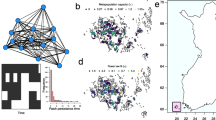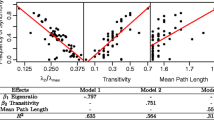Abstract
We examine the dynamics of oscillating populations in habitats described as networks of connected patches where the connections are not regular. This system would be typically analysed focusing either on the population dynamics, or measuring dispersal directly or indirectly. We focus on the question of the degree to which the dynamical patterns, as reflected in synchrony, reveal the underlying dispersal pathways. This would represent a bridge between two major spatial approaches: topological and dynamical. We show how local populations can be synchronized even if there is no direct dispersal route between them, while the stepping-stone populations are not synchronized. This leads to the surprising result that the topological structure of the underlying network is not reflected simply in patterns of synchrony across space in population dynamics. This shows that, with our current tools, the complex relationship between the underlying dispersal patterns and population dynamics prevent us from determining network structure through the observation of population dynamics.




Similar content being viewed by others
References
Albert E M, Fortuna M A, Godoy J A, Bascompte J (2013) Assessing the robustness of networks of spatial genetic variation. Eco Lett 16:86–93
Bjørnstad ON, Ims RA, Lambin X (1999a) Spatial population dynamics: analysing patterns and processes of population synchrony. Trends Ecol Evol 11:427–431
Bjørnstad ON, Stenseth NC, Saitoh T (1999b) Synchrony and scaling in dynamics of voles and mice in northern Japan. Ecology 80:622–637
Crooks KR, Sanjayan M (eds) (2006) Connectivity conservation. Cambridge University Press
Dyer R J, Nason J D (2004) Population graphs: the graph theoretic shape of genetic structure. Mol Ecol 13:1713–1727
Eguíluz V M, Chilavo D R, Cecchi G A, Baliki M, Apkarian A V (2005) Scale-free brain functional networks. Phys Rev Lett 94:18102
Erdös P, Rényi A (1959) On random graphs {I}. Publ Math 6:290–297
Fortuna M A, Albaladejo R G, Fernández L, Aparicio A, Bascompte J (2009) Networks of spatial genetic variation across species. P Natl Acad Sci USA 106:19044–19049
Gilarranz L J, Bascompte J (2012) Spatial network structure and metapopulation persistence. J Theor Biol 297:11–16
Girvan M, Newman M E J (2002) Community structure in social and biological networks. P Natl Acad Sci USA 99:7821–7826
Goldwyn E E, Hastings A (2008) When can dispersal synchronize populations? Theor Popul Biol 73:395–402
Goldwyn E E, Hastings A (2009) Small heterogeneity has large effects on synchronization of ecological oscillators. B Math Biol 71:130–144
Guimerà R, Amaral L A N (2005) Functional cartography of complex metabolic networks. Nature 433:895–900
Hanski I, Woiwod I P (1993) Spatial synchrony in the dynamics of moth and aphid populations. J Anim Ecol 62:656–668
Hanski I A, Gilpin M E (eds) (1997) Metapopulation biology, ecology, genetics and evolution. Academic Press, San Diego
Hastings A, Botsford L W (2006) Persistence of spatial populations depends on returning home. P Natl Acad Sci USA 103:6067–6072
Holland M D, Hastings A (2008) Strong effect of dispersal network structure on ecological dynamics. Nature 456:792–794
Jordano P, García C, Godoy J A, García-Castaño J L (2007) Differential contribution of frugivores to complex seed dispersal patterns. P Natl Acad Sci USA 104:3278–3282
Kaneko K (1998) Modelling spatiotemporal dynamics in ecology, Springer-Verlag, chap Diversity, pp 27–41
Kirkpatrick S, Gelatt C D, Vecchi M P (1983) Optimization by simulated annealing. Science 220:671–680
Liebhold A M, Koenig W D, Bjørnstad ON (2004) Spatial synchrony in population dynamics. Annu Rev Ecol Evol S 35:467–490
Maslov S, Sneppen K (2002) Specificity and stability in topology of protein networks. Science 296:910–913
May R M (1972) Will a large complex system be stable? Nat 238:413–414
May R M, Oster G F (1976) Bifurcations and dynamic complexity in simple ecological models. Am Nat 110:573–599
Nathan R (2006) Long-distance dispersal of plants. Sicence 313:786–788
Powney G D, Roy D B, Chapman D, Brereton T, Oliver T H (2011) Measuring functional connectivity using long-term monitoring data. Methods Ecol Evol 2:527–533
Rasmussen D R, Bohr T (1987) Temporal chaos and spatial disorder. Phys Lett A 125:107–110
Ricker W E (1954) Stock and recruitment. J Fish Res Board Can 11(5):559–623
Rozenfeld F A, Arnaud-Haond S, Hernández-Garcá E, Eguíluz V M, Serrão E A, Duarte C M (2008) Network analysis identifies weak and strong links in a metapopulation system. P Natl Acad Sci USA 105:18824–18829
Schroeder M (1991) Fractals, chaos and power laws. W.H. Freeman and Co
Siegel D A, Mitarai S, Costello C J, Gaines S D, Kendall B E, Warner R R, Winters K B (2008) The stochastic nature of larval connectivity among nearshore marine populations. P Natl Acad Sci USA 105:8974–8979
Solé R V, Bascompte J, Valls J (1992) Nonequilibrium dynamics in lattice ecosystems: chaotic stability and dissipative structures. Chaos 2:387–395
Stewart I (1989) Does God play dice? Blackwell, Oxford
Stouffer D B, Bascompte J (2011) Compartmentalization increases food-web persistence. P Natl Acad Sci USA 108:3648–3652
Swearer S E, Caselle J E, Lea D W, Warner R R (1999) Larval retention and recruitment in an island population of a coral-reef fish. Nat 402:799–802
Urban D, Keitt T (2001) Landscape connectivity: a graph-theoretic perspective. Ecology 85(5):1205–1218
Wysham D, Hastings A (2008) The coupled two-patch ricker population model: transients explained. B Math Biol 70:1013–1031
Acknowledgments
This work was funded by the European Research Council through an Advanced Grant (to JB), the Spanish Ministry of Education trough a FPU PhD Fellowship (to LJG), and US National Science Foundation Grant EF-0742674 (to AH).
Author information
Authors and Affiliations
Corresponding author
Electronic supplementary material
Below is the link to the electronic supplementary material.
Rights and permissions
About this article
Cite this article
Gilarranz, L.J., Hastings, A. & Bascompte, J. Inferring topology from dynamics in spatial networks. Theor Ecol 8, 15–21 (2015). https://doi.org/10.1007/s12080-014-0231-y
Received:
Accepted:
Published:
Issue Date:
DOI: https://doi.org/10.1007/s12080-014-0231-y




